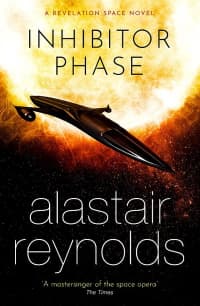
Inhibitor Phase by Alastair Reynolds
(Gollancz, 2021)
Reviewed by Ben Jeapes
Eighteen years since the last novel set directly in the Revelation Space storyline. Memories blur; you have vague ideas of what went before but that's all. This is fine because the narrator has deliberately buried his own memories and has to do a lot of recovering.
He is Miguel de Ruyter, leader of a small colony cowering on a small and far-off planet; quite possibly the last humans left alive, though they have no way of knowing for sure. They are deliberately keeping the lowest-possible tech profile so as not to attract the attentions of the wolves — the roaming swarms of Inhibitors, awoken in earlier novels and mindlessly devoted to their ancient raison d’etre of erasing sentient civilisation. Miguel is plucked from home and family by the barely human female Glass and taken on a mission that could finally put paid to the Inhibitor threat.
The Revelation Space universe was pretty well laid out — beginning, middle and end, not necessarily in that order — in a series of novels and stories twenty years ago, but it's wonderful to see that it can still unfold into new levels. Aficionados will already know what happens to the galaxy, but not necessarily how we get there, and that doesn’t matter. The timescales involved still allow for plenty of human storytelling, and the novel is only partly about filling in some of the blanks. The rest is a story of humanity and redemption. Reynolds manages to make sympathetic characters out of war criminals without once glossing over their crimes.
This is possibly the most immediately accessible of the Revelation Space novels, whether you know the back story or not: enough information is given straight up to put the reader right into the story. It is such a long time after the other series titles that the necessary backfilling can be done quite naturally. (Just in case, the volume includes a handy glossary, chronology and who’s who, but you really don’t need it.)
There were times when it almost seemed like Reynolds was writing his own fan fiction, digging up and bringing together names (usually under other names) that we haven't seen for years. We've met Miguel before, as we have several other characters who know exactly who they are but who now go by different names and who have also changed over the intervening centuries of the storyline. You will probably guess who Miguel is but unless you go a long way back in the storyline there's a 50/50 chance you will guess wrong.
Glass and Miguel have similar aims so it would be far more helpful if she just told him what she was doing, avoiding all those times he tries to kill her and she says something like “I'd have been disappointed if you hadn't tried that.” And it is sometimes talky…
…But then you get edge-of-the-seat action to make up for it, and the searing images required of all good space opera. If you remember and love Chasm City from the belle epoque of earlier novels, the post-Inhibitor desolation brings tears to the eyes. The almost obligatory prog rock reference is slyly made and fits seamlessly into the plot logic; I leave it to the discerning reader to find it.
After finishing the novel, I realised there was one scene that still stood out. It could have been omitted altogether at no expense to the story logic, but it is the defining moment of the book’s values. This is the entire section simply called ‘Triage’ and is a wonderful affirmation of human values in this semi post-human future. After half a book of pragmatic decision-making we get pure altruism from an unexpected direction: exemplary and unsolicited humanity shown by a cybernetic spaceship to a group of non-humans. And it is this that makes the book shine.
Review from BSFA Review 16 - Download your copy here.
